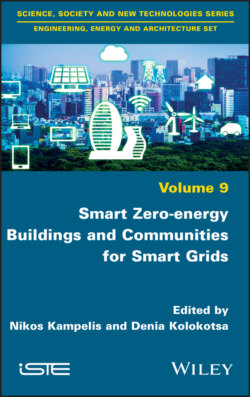Читать книгу Smart Zero-energy Buildings and Communities for Smart Grids - Группа авторов - Страница 17
1.2. Smart and zero-energy communities
ОглавлениеMoving from the building to the community level, the requests of the future communities are very demanding. They should be places of advanced social progress and environmental regeneration, as well as places of attraction and engines of economic growth based on a holistic integrated approach in which all aspects of sustainability are taken into account.
As mentioned in the Leipzig Charter (http://ec.europa.eu/regionalpolicy/archive/themes/urban/leipzigcharter.pdf), sustainable communities and cities should:
– Create a suitable environment for urban populations that can attract industry, businesses, tourism and workforces.
– Modernize the infrastructure networks. This approach is about achieving a high-quality and affordable urban transport system that includes a network linking the city to the region, as well as providing and improving supply networks such as energy, waste-water treatment and water supply.
– Ensure the efficient use of natural resources, economic efficiency and the energy efficiency in new and existing buildings.
The National Renewable Energy Laboratory defined the zero-energy community as “one that has greatly reduced energy needs through efficiency gain such that the balance of energy for vehicles, thermal, and electrical energy within the community is met by renewable energy” (Carlisle et al. 2009) and “community scenarios could link transportation, home and the electric grid as well as enable large quantities of renewable power onto the grid”.
Therefore, a smart zero-energy community (http://www.smartcommunities.org) is a region where its citizens and local authorities are exploiting the information technology to “transform life and work in significant and fundamental rather than incremental ways” to meet the aforementioned strategies and objectives. As mentioned on the Smart Communities website: “The goal of such an effort is more than the mere deployment of technology. Rather it is about preparing one’s community to meet the challenges of a global, knowledge economy.”
Smart grids can be the basis of smart zero-energy communities offering:
1) Reliability and security as the prominence of information technology.
2) Optimal operation, thus contributing to a generation–consumption matching (Kolokotsa et al. 2011) through the full exploitation of low zero carbon (LZC) emission technologies (Carlisle et al. 2009; Xue et al. 2014).
3) Adaptation to the rapidly evolving ICT technologies, as well as exploitation of the internet’s capabilities, smart devices and applications (Zhen et al. 2012).
4) The necessary balance between the energy demand and energy production on the community, neighborhood and district level, contributing to the smart and sustainable urban environment.
Effective management of the intermittency of renewable energy sources power generation as well as of operational and capacity reserve in conjunction with the buildings’ energy demand profiles. In order to understand more clearly the role of smart grids in zero-energy communities, some examples are presented in the next paragraphs. More details on smart grids worldwide popularity can be found in Bartels (2012).
Figure 1.1. Components of the smart grid
The role of net energy metering and the time of use rate in the electricity demand of a zero-energy apartment community have been investigated (Gaiser and Stroeve 2014). The apartments’ community is placed in West Village in Davis, California. Smart scheduling is applied in order to achieve peak load shaving by using the various household appliances during off-peak hours. The peak demand is reduced by 18%, the part-peak demand by 32%, and the off-peak demand is increased by 12%. Since the apartments are using photovoltaics for electricity, the community’s occupants can benefit significantly if the surplus generation by the photovoltaics is maximized and sold to the grid during peak hours (Figure 1.1).
Moreover, a low energy community configuration for the Island of Hawaii is proposed in Zhang (2009). The overall work included energy production using photovoltaics, storage systems using batteries and compressed air systems, demand response of buildings, passive cooling techniques for energy efficiency as well as microclimate and landscape assessment.
An advanced energy management and optimization model for the operation of the Leaf Microgrid Community is proposed by Kolokotsa et al. (2015). The aim of the model is to minimize the energy cost of the microgrid by performing a generation–consumption matching using genetic algorithms. The optimization procedure is supported by power load forecasting and energy production prediction (by the photovoltaics and hydroelectric plant) using artificial neural networks. While the optimization horizon is 24 hours ahead, the optimization and management procedure leads to an almost 6% reduction in the energy costs for the microgrid and significant cost savings for the community without extra energy investment.
Similar works include apart from genetic algorithms (Liang and Gooi 2010; Mohamed and Koivo 2012) the use of fuzzy logic and the particle swarm optimization method (Kyriakarakos et al. 2012) as well as the non-linear constraint multi-objective optimization method (Mohamed and Koivo 2007).
Another potential application of smart grids at the community level is the operation of small and medium enterprises (SMEs) which have multiple operational characteristics ranging from office buildings, retail, industrial, etc. and different energy patterns and needs (Rawlings et al. 2014). Though the potential for carbon reduction of SMEs is unclear due to the diversity of the end uses, smart grids can be a viable tool for SME decarbonization since additional data can be available through detailed smart metering. Therefore, the electricity loads of the SMEs can be discretized and the proportions that are available for load shifting or shaving can be more easily identified.
These can be space heating, cooling and hot water in the commercial sector, and heating or cooling in industry.
Last but not least, the social aspects of smart grids at the community level should be clearly examined. The fast promotion of smart grids’ capabilities and potential applications will be much easily understood by local communities if social inclusion is taken into account. The role of social experts in this aspect is of great importance (Wolsink 2012).
